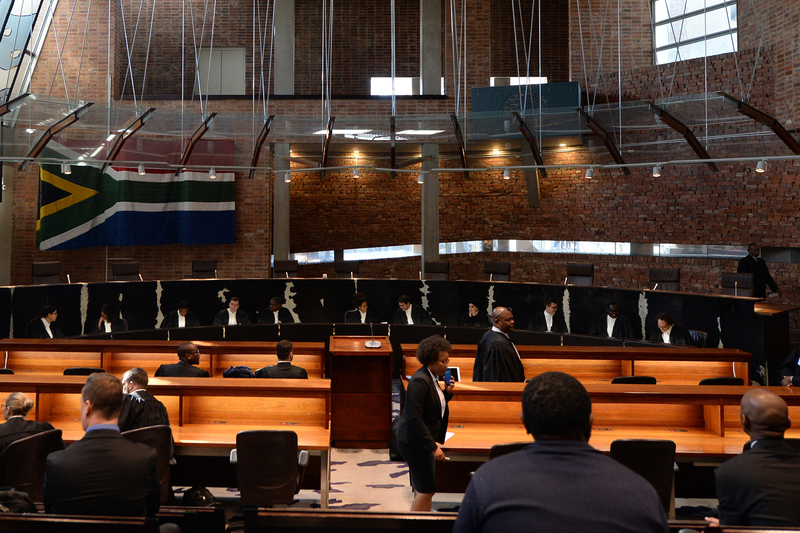Hate speech and the right to freedom of expression
04 August 2021 | Story Pierre de Vos. Photo Felix Dlanagamandla / Gallo Images. Read time 6 min.
Professor Pierre de Vos, the head of the Department of Public Law at the University of Cape Town (UCT), reflects on the Constitutional Court of South Africa’s recent judgment in Qwelane v South African Human Rights Commission and Another and its implications for hate speech.
Although the court found that section 10(1) was unconstitutional and invalid, it nevertheless held that Qwelane was guilty of hate speech in terms of a reworked, constitutionally compliant, version of section 10(1). The judgment considerably narrows the scope of prohibited hate speech, while rejecting the libertarian view of freedom of expression embraced by the Supreme Court of Appeal in its earlier Qwelane judgment.
Ever since the Prevention of Unfair Discrimination Act (Pepuda) came into force almost 20 years ago, different courts had interpreted and applied the prohibition on hate speech in section 10(1) of Pepuda in markedly different ways, creating much confusion and uncertainty.
To add to the uncertainty, some courts have suggested that section 10(1) was constitutionally invalid because it regulated speech protected by section 16(1) of the South African Constitution, casting doubt on the validity of various hate speech rulings. It is, therefore, a relief that the Constitutional Court, in its recent judgment in Qwelane v South African Human Rights Commission and Another, finally clarified matters, and that it did so in a way that seriously grappled with the impact of structural inequality on the intensity and nature of harm caused by specific types of speech.
Recall that, in its original form, section 10(1) of Pepuda prohibited any person from publishing, propagating, advocating or communicating words that are based on prohibited grounds like race, sex, gender and sexual orientation, religion, belief and disability, against any other person, where the words could “reasonably be construed to demonstrate a clear intention (a) to be hurtful; (b) be harmful or to incite harm; (c) promote or propagate hatred.”
As some lower courts previously did, the Supreme Court of Appeal (SCA) in its Qwelane judgment interpreted the underlined words above disjunctively (as if there was an “or” and not an “and” between each subsection) and found that section 10 established three distinct grounds on which hate speech could be based.
Section 10(1) thus prohibited speech targeting a person based on their race, sex, gender, sexual orientation that could reasonably be construed to be merely “hurtful” to that person — regardless of whether the speech was reasonably intended to be harmful or inciting harm, or promote hatred against that group. The SCA then declared section 10 unconstitutional to the extent that it prohibited speech merely intended to be “hurtful”, and because it included speech targeting grounds other than race, ethnicity, gender, religion or sexual orientation.
The Constitutional Court confirmed the SCA finding that section 10 was unconstitutional, on the basis that it included the term “hurtful” in the definition of hate speech, but its general approach to hate speech differed sharply from that of the SCA (more on this below). Consequently, the Constitutional Court gave Parliament 24 months to correct this unconstitutionality and ordered that until that happens section 10(1) should read as follows: “… no person may publish, propagate, advocate or communicate words that are based on one or more of the prohibited grounds, against any person, that could reasonably be construed to demonstrate a clear intention to be harmful or to incite harm and to promote or propagate hatred.”
Not only does this interim definition exclude any mention of “hurtful” speech, it also requires the subsections to be read conjunctively. This means speech can only constitute hate speech if it targets individuals based on their race, sex, gender, sexual orientation or other prohibited grounds and could reasonably be construed as having the intention to be both harmful or to incite harm and to promote or propagate hatred.
Read on its own, the court’s reworked definition of hate speech does not depart radically from the various approaches taken by lower courts — including by the SCA. Moreover, like the SCA, the Constitutional Court acknowledges that “the expression of unpopular or even offensive beliefs does not constitute hate speech”.
“[E]xtreme detestation and vilification which risks provoking discriminatory activities against that group. Expression will constitute hate speech when it seeks to violate the rights of another person or group of persons based on group identity. Hate speech does not serve to stifle ideology, belief or views. In a democratic, open and broad-minded society like ours, disturbing or even shocking views are tolerated as long as they do not infringe the rights of persons or groups of persons.”
But it is important to understand that the Constitutional Court approached the problem of hate speech, and how to identify the kinds of speech-harm that could permissibly be regulated, in a radically different way than the SCA did. Specifically, the Constitutional Court recognised that hate speech must be understood based on the different structural positions occupied by different groups and must take cognisance of how words “contribute towards creating or exacerbating systemic disadvantage and subordination”.
Relying on its earlier jurisprudence that recognised “the presence of deeply rooted structural subordination in relation to race”, it also noted that the Qwelane case vividly demonstrates the “continuing structural subordination and vulnerability relating to sexual orientation and gender identity”.
This approach recognises that objectionable or offensive speech is more likely to have an impermissible harmful impact on individuals from subordinated groups (in most contexts, this would be black people, women, LGBTQ+ people) than on individuals from socially privileged and dominant groups (in most contexts this would be white people, men, heterosexuals). The identity and status of the speaker and the individuals being targeted by the speech, the historical context and circumstances in which the speech occurred, and to what extent the speech perpetuates the structural subordination and vulnerability of the targeted group, must thus be considered when applying the section 10(1) test.
For example, and simplifying slightly, this approach suggests that when a white person targets black persons because of their race by using the “k” word and other racial slurs in order to humiliate and silence them and to assert his or her imagined racial superiority, the intensity of the harm would be greater than when a black person targets white persons by referring to them as “Boers” and accusing them of stealing the land. This is because the latter speech is not likely to produce or reinforce the subordination of white people.
Similarly, the intensity of the harm will be judged to be greater when a heterosexual targets gay men by calling us “moffies” and accusing us of paedophilia, than when a gay man calls a heterosexual man a “breeder”, or a patriarchal bigot. Of course, in all cases, the context in which words were spoken, the actual words used, and other relevant factors may also influence the assessment.
The reasoning employed by the court to justify its conclusion that Qwelane was guilty of hate speech in terms of the revised text of section 10(1) of the Constitution, provides further insight into the Constitutional Court’s approach. Noting that Qwelane vilified the LGBT+ community as “animals”, as less than human beings, and equated our sexuality with bestiality, the court concluded that the article unabashedly exuded his loathing and revulsion for LGBTQ+ people. But it went further by recognising that:
“Homophobic speech is part and parcel of the broader system of homophobia and transphobia in South African society which includes both hate speech and violent crimes perpetrated against members of the LGBT+ community. Homophobic speech is not only problematic because it injures the dignity of members of the LGBT+ community, but also because it contributes to an environment that serves to delegitimise their very existence and their right to be treated as equals. Hate speech regulation in our country ought in my view to be grounded in the express anti-racist and anti-sexist tenets of our Constitution. In this respect, our jurisprudence is unique because of its strong pronouncements on the transformative nature of the Constitution and its aim of eradicating the remnants of our colonial and apartheid past.”
This passage (there are similar passages elsewhere in the judgment) makes clear that the court views the regulation of hate speech as a positive proactive step aimed at protecting victims from the infringement of their right to equality and non-discrimination.
When one lives in an environment that delegitimises your existence and your right to be treated as an equal purely on the basis of your sexual orientation or gender identity, or your race, sex, or gender (or combinations of the above), you are likely to be discriminated against by others in a million different ways. As we know, you are also more likely to be assaulted and killed in such an environment. This is an insight that tends to come slowly to the privileged whose life is not rendered precarious by racism, sexism, homophobia and anti-poor prejudice.
Despite the positive appraisal above, I found some aspects of the court’s reasoning confusing, and the mistakes that slipped through (such as that the judgment contains two different versions of the adjusted text of section 10(1)) worrying. But that is a discussion for another day.










